NVIDIA's GeForce GTX 560 Ti: Upsetting The $250 Market
by Ryan Smith on January 25, 2011 9:00 AM ESTPower, Temperature, & Noise
Last but not least as always is our look at the power consumption, temperatures, and acoustics of the GTX 570. While NVIDIA chose to optimize for both performance and power on the GTX 570/580, the GTX 560 Ti is almost exclusively optimized for performance. As a result NVIDIA’s official TDP has gone up by 10W, and as we’ll see in practice the difference is even greater than that.
| GeForce 400/500 Series Load Voltage | ||||
| Ref GTX 560 Ti | Ref GTX 460 1GB | Ref GTX 460 768MB | ||
| 0.950v | 1.025v | 0.987v | ||
Starting with VIDs, we once again only have 1 card so there’s not too much data we can draw. Our GTX 560 sample has a VID of 0.95v, which is actually lower than our reference 1GB card, which had a VID of 1.025v. NVIDIA’s transistor optimizations can allow them to run their cards at lower voltages compared to the earlier designs, but at the same time based on our data a lower VID appears to be critical for keeping the GTX 560 Ti’s power consumption from significantly growing versus the GTX 460. This is not wholly unexpected – GF104 never suffered from leakage nearly as badly as GF100 did.
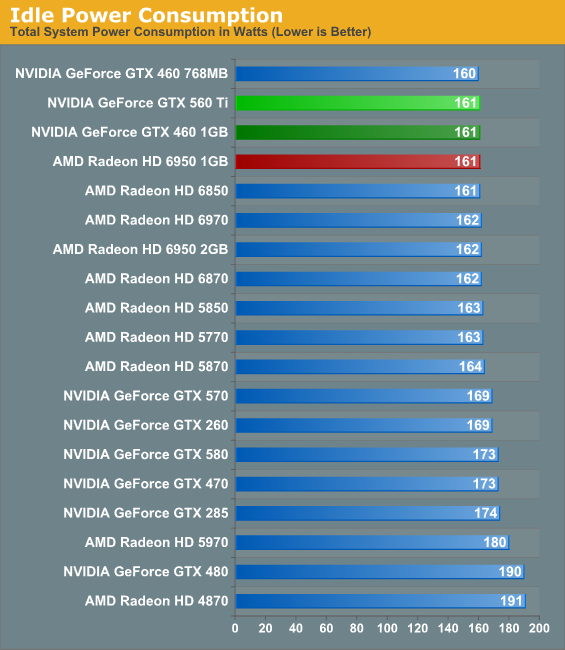
Idle power is effectively a wash here. The GTX 560 Ti does have additional functional units which are now consuming power even when the GPU is idling, but at the same time the transistor changes are keeping idle power in check. At 161W it’s as good as the rest of our mid-range cards.
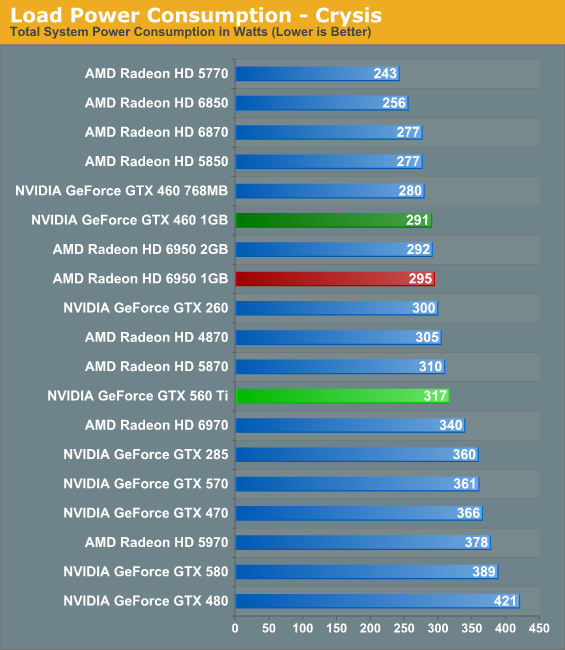
Under Crysis we get our first glimpse that while NVIDIA’s TDP may only be 10W higher, the real world difference is greater. While we cannot isolate just the power consumption of the video card, and we can explain at least some of the difference as being a result of a greater workload on the CPU due to a higher framerate, we can’t fully explain away the difference between the GTX 460 1GB and the GTX 560 Ti. With a 26W delta, we’re confident the extra power draw we’re seeing with the GTX 560 Ti is well over 10W – and keep in mind this is a game test where our numbers are similar to how NVIDIA defines their TDP. Performance per watt is always increasing, but for a mid-range card the GTX 560 Ti doesn’t do so hot here, and as a result it’s a bit worse than even the quite similar Radeon HD 5870.
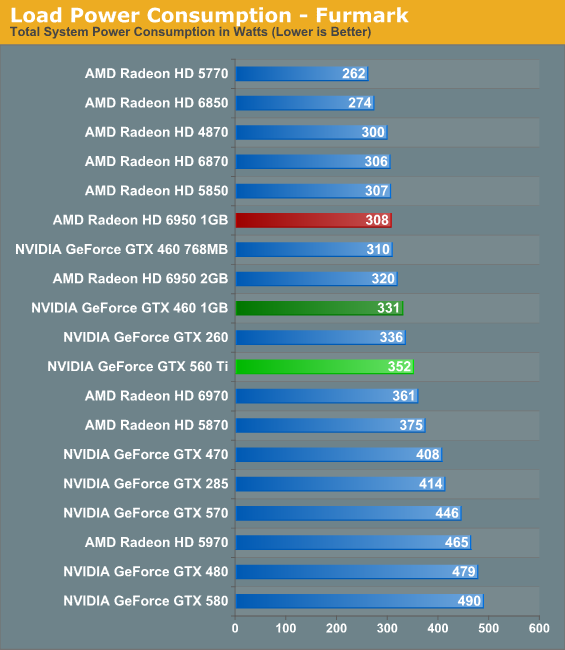
Under FurMark the gap between the GTX 460 1GB and GTX 560 Ti shrinks some, even after we disable the GTX 560 Ti’s overcurrent protection. It’s now a 21W gap, which is still more than we’d expect given NVIDIA’s official TDP numbers. Furthermore AMD’s PowerTune technology makes NVIDIA look quite bad here – the 200W capped 6950 1GB rig is drawing 44W less, and even the 6970 rig is only drawing 9W more. As we said when AMD first introduced PowerTune, we’re not against TDP-limited technologies so long as they’re done on a truly application-wide basis – so hopefully at some point we’ll see NVIDIA’s overcurrent protection technology evolve in to something closer to PowerTune instead of something that merely targets 2 of many stress testing applications.
The ultimate lesson from this however is that it once more reiterates the importance of good case cooling when using open-ended cards that don’t fully exhaust their hot air, such as the GTX 460 and GTX 560. Our airy GPU test bed has no problem with these cards, but at the end of the day you’re looking at 200W of heat and only around half of which is getting blown out of the case, leaving another 100W for the case to deal with. It’s a reasonable design choice on NVIDIA’s part, but it means you need to use the right case for the job. The GTX 560 Ti makes this all the more important, and I suspect we may be at the limits of what’s practical for a non-blower card.
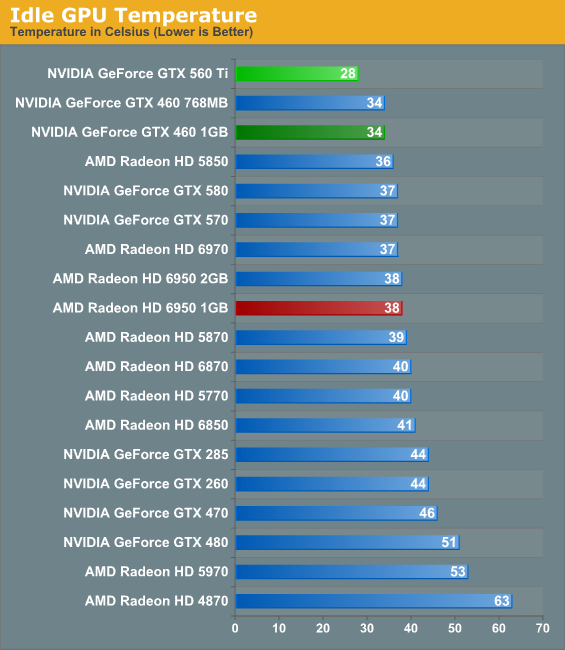
What do you get when you combine a large, open-air video card with an equally large and airy GPU test rig? Very, very low idle temperatures. Last year the GTX 460 set a new mark on our rig at 34C for idle, but with a bigger cooler and similar idle power consumption numbers, the GTX 560 Ti takes this one step farther. At 28C not only is the GTX 560 Ti several degrees cooler than the aforementioned GTX 560s, but it’s also only several degrees off of room temperature. This is something a blower design such as the GTX 570 or Radeon HD 6950 simply cannot match, even if idle power consumption is similar.
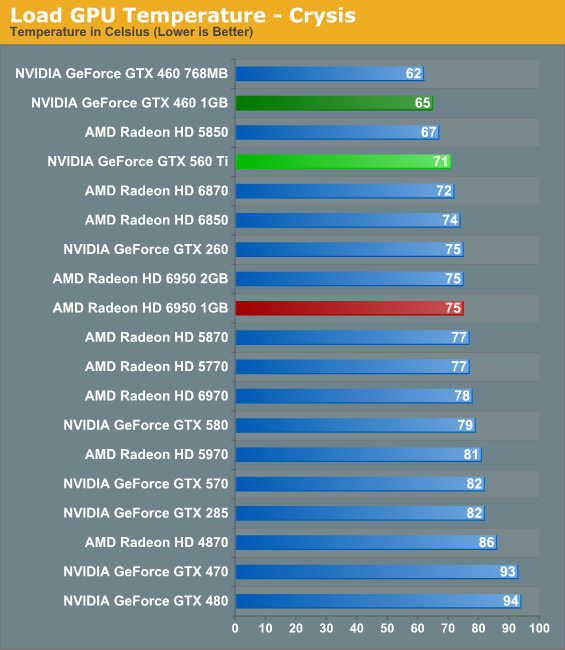
Compared to idle things end up being a little less rosy for the GTX 560 Ti, but they still look good. Even with a bigger cooler the GTX 560 cannot match the GTX 460s, but it’s doing fairly well against everything else. The open-air design still gives it an advantage versus blowers, but not by quite as much – the 6950 is only 4C off. Given that we figure the actual power consumption of the GTX 560 Ti is around 20W more than the GTX 460 1GB, it looks like the GTX 560 Ti’s cooler can’t fully make up for the additional heat the GTX 560 Ti’s GPU puts off.
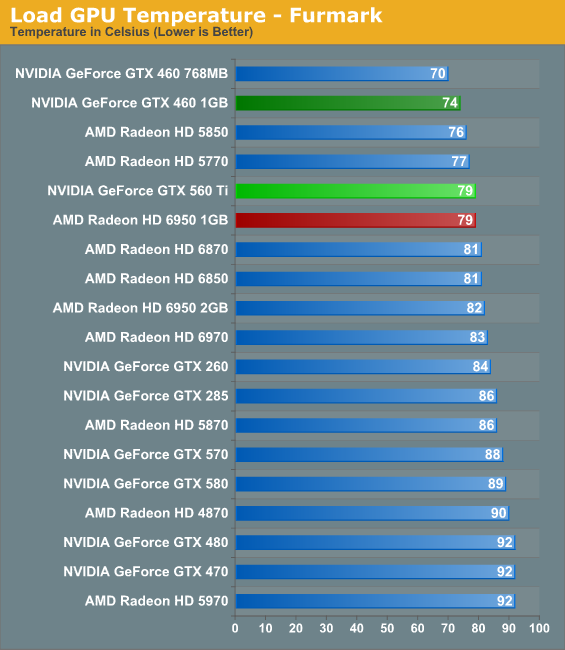
Under FurMark the story is quite similar. The GTX 560 Ti again is several degrees warmer than the GTX 460, and AMD’s blowers do start catching up thanks to PowerTune. Otherwise at 79C the card still runs quite cool, merely not as cool as the GTX 460 before it. When we get to our noise data however, we’ll see that NVIDIA may have optimized the GTX 560 for noise ahead of temperatures more than they did the GTX 460.
With that said, based on our numbers and TDP estimations though, we’re all the more curious at just how much case cooling is necessary for the GTX 560, and if it’s going to be as flexible as the GTX 460. It may be worth building a secondary GPU test rig with poor ventilation to see if the GTX 560 Ti is still suitable under sub-optimal conditions.
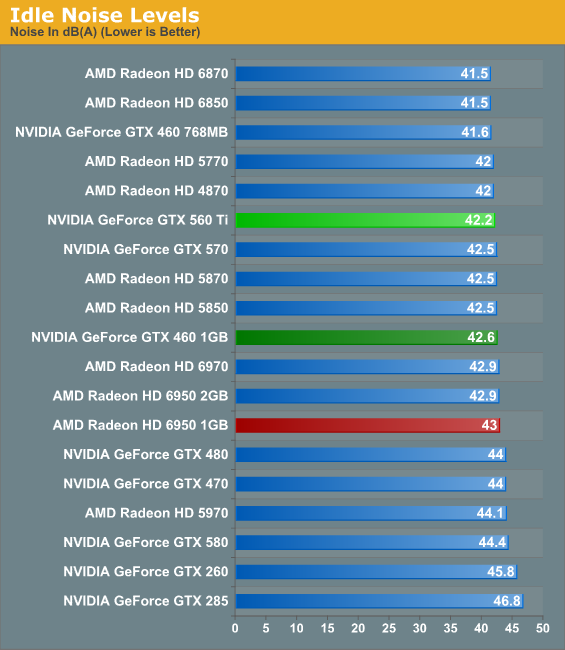
At idle virtually all of our cards run up against the noise floor, so there’s little to be surprised about here. The GTX 560 Ti is effectively as good as everything else.
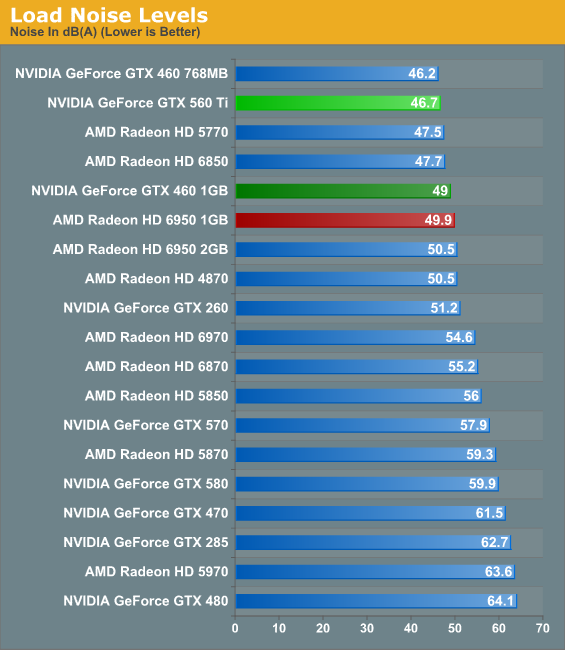
It’s our load noise values that make us reconsider our earlier temperature data. While the GTX 560 Ti may run hotter than a GTX 460, NVIDIA clearly didn’t lose their knack when it comes to noise. The GTX 460 768MB set a new record for a mid-range card, and the GTX 560 Ti is the second –best, besting even the GTX 460 1GB by a bit over 2dB. When it comes to our GPU testbed the GTX 560 is just shy of silent, which is quite an accomplishment for as much power as it consumes. This also handily illustrates why we don’t consider the Radeon HD 6870 to be much competition for the GTX 560 Ti – it may be cheaper, but it’s also a heck of a lot louder. It takes a 6950 to find an AMD card with similar performance that has acoustic qualities in the same neighborhood.










87 Comments
View All Comments
martixy - Tuesday, January 25, 2011 - link
Looks quite good.Would get it for the GP compute power just as much as the pixel-pushing power.
I just question the end price in my little corner of the world. :) Most likely it will be double that($249). 250 I can do, 500 - nah... Go figure.
tonyblair - Tuesday, January 25, 2011 - link
Ah, do my eyes decieve me or has good old Anandtech gone back to using bog standard reference GTX460's for Nvidia launches? Haha.mapesdhs - Wednesday, January 26, 2011 - link
Yeah, it's kinda lame, given nobody in their right mind would buy a stock 460
anymore. Many places don't even sell them now, and a highly oc'd 460 is
easily $50 to $60 less than a 560, so a proper comparison would be useful.
Alas, they succumbed to the moaning minnies.
If anyone's interested, I can run the downloadable Stalker COP benchmark
using this review's settings (my own 460 FTW tests have been using 1920x1080,
Extreme detail, SSAO = Default/High, Enhanced Full Dynamic Lighting, so not
directly comparable).
I can't test 2560x1600, but I can test 1680x1050 and 1920x1200, also with
FTW SLI.
Ryan, what full settings did you use for the Stalker test? ie. the SSAO (or
other) mode, etc.?
Ian.
JimmiG - Wednesday, January 26, 2011 - link
I agree.. GTX460 cards are available at speeds up to 850MHz or perhaps even more, a huge difference from the 675MHz that the card supposedly launched at (though even at launch, cards running at anything under 7xx MHz was pretty rare).Parhel - Wednesday, January 26, 2011 - link
Ha! I just bought a stock 460 1GB two weeks ago. Terribly cheap cooler, so the thing only OC's to about 750Mhz before it throttles and I have to reboot. But I only paid $130, so I'm thrilled with the card. I'm on 2560x1600 screen, otherwise the 768MB card would have been the better value.overzealot - Tuesday, January 25, 2011 - link
I remember the Geforce 2 Ti, back in 2001.It wasn't the highest end offering then, either - but it sure was a great cost/performance offer.
It's so bad!
Belard - Thursday, January 27, 2011 - link
The GF2ti was really a die-shrink GF2Pro at 50Mhz faster GPU clock, nothing more. In the real world, it was cheaper than the GF2Pro and was a new CHIP process/series they used for the GF3-TI series. Still, the GF2ti was a pretty good deal in its day at about $125 or so... far cheaper than the $300 GT2-Ultra which just lost its crown to the GF3 series.A little history lesson.
All GF400mx /4000mx series are GF2 technology built on a smaller process, nothing more. Sadily, even now, you can STILL buy NEW GF2mx and GF4000MX cards. The 4000MX is a Frankenstein card. Nvidia took a very slow GF2mx GPU and stuck in DX8...
Check out the stats on Wikipedia - (Basic mid-range cards $200~250)
GF2ti (2001 - 10 years ago) = Fillrate = 00.2 GT/s Bandwidth = 006.4 GB/s DX7
GF4 4200 TI (2002 favorite) = Fillrate = 00.2 GT/s Bandwidth = 008.0 GB/s DX8
GF 6600GT (2004 favorite) = Fillrate = 04.0 GT/s Bandwidth = 014.0 GB/s DX9
GF GTX 260 (2008 favorite) = Fillrate = 41.4 GT/s Bandwidth = 112.0 GB/s DX10
GF GTX 560 (2011 Today) = Fillrate = 52.6 GT/s Bandwidth = 128.2 GB/s DX11
*While the fillrate of GF2 & GF4 are the same, GF2 is a DX7 card, so the GF4 might do the DX7 benchmark at 0.3~.4.
Wow, bandwidth wise, the 560 is 20x faster than the old GF2. Graphic Texture Fillrate is way beyond what those old GF2~4 cards could handle.
Hence, playing Crysis on 560 in 1280x1024 could be around 65fps, on a GF6600, it would be under 10fps with LOW details and maybe 1 frame every 6~10 seconds on the GF2... :)
Lepton87 - Wednesday, January 26, 2011 - link
This card hardly even caught up to my over-a-year-old Radeon 5870. I don't know why this card looks comparatively slow in anandtech's reviews whilst on other tech sites it is about on par with 6950 and thus ever-so-slightly faster then 560Ti.http://www.techpowerup.com/reviews/NVIDIA/GeForce_...
so far I find those charts the most informative when it comes to relative performance between cards. It looks like anandtech's blend of games somewhat favor NV hardware.
SolMiester - Wednesday, January 26, 2011 - link
This is a mid range card that in some benchies surpasses your high previous generation card, at a cheaper price, is quieter and smaller to boot. What more do you want?MeanBruce - Wednesday, January 26, 2011 - link
The Asus 560 looks really amazing, guess it's faster than my brand new Asus 6870 directcu, but that's ok I knew the 560 was coming out, and wanted the Asus 6870 for it's beautiful triple heatpipe and gorgeous backplate heatsink the way it looks thru the window of the Corsair Obsidian 650D. Yup it's not out yet, April but man thru that window with my new Corsair AX850! I'm just buying parts for a window! Oh man the sweetness, that view while I work with Microsoft Word. The 6870 came with dual full sized DisplayPorts fantastic, but the Asus 560 comes with just a mini-HDMI. What is that all about? I didn't even know they came in mini. Maybe AMD will release the 7000 series early this year die shrink and all, 7870 for Christmas ahhh life is good.